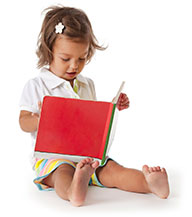Literacy
 Development in the domain of literacy serves as a foundation for reading and writing acquisition.
Development in the domain of literacy serves as a foundation for reading and writing acquisition.
The development of early literacy skills is critically important for children’s future academic and personal success. Yet children enter kindergarten varying considerably in these skills; and it is difficult for a child who starts behind to close the gap once they enter school (National Early Panel, 2008). The components within this domain address phonological awareness, alphabet knowledge, print awareness, text comprehension and interest, and emergent writing.
As a growing number of children live in households where the primary spoken language is not English, this domain also addresses the literacy development of multilingual learners. However, specific age thresholds do not define the indicators for literacy development in English, unlike most of the other developmental progressions. Children who become multilingual learners are exposed to English (in this country) for the first time at different ages. As a result, one child may start the process of developing English literacy skills very early in life and another child not until age four, making the age thresholds inappropriate. So instead of using age, The RIELDS use research-based age ranges to outline a child’s progress in literacy development. It is important to note that there is no set time for how long it will take a given child to progress through these stages. Progress depends upon the unique characteristics of the child, their exposure to English in the home and other environments, the child’s motivation to learn English, and other factors.
Children with disabilities may demonstrate alternate ways of meeting the goals of literacy development. For example, a child with a visual impairment will demonstrate a relationship to books and tactile experiences that is significantly different from that of children who can see. As well, children with other special needs and considerations may reach many of these same goals, but at a different pace, in a different way, with a different degree of accomplishment, or in a different order than their peers. However, the goals for all children are the same, even though the path and the pace toward realizing the goals may be different. Principles of universal design for learning (UDL) offer the least restrictive and most inclusive approach to developing environments and curricula that best support the literacy development of all children.
Remember:
While this domain represents general expectations for literacy development, each child will reach the individual standards at their own pace and in their own way.
